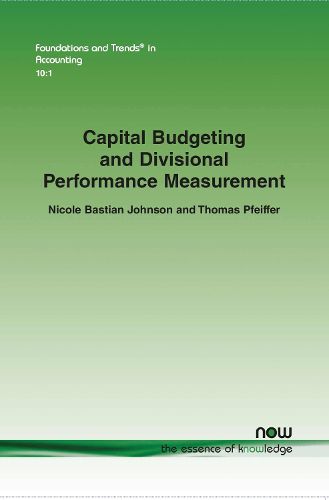Readings Newsletter
Become a Readings Member to make your shopping experience even easier.
Sign in or sign up for free!
You’re not far away from qualifying for FREE standard shipping within Australia
You’ve qualified for FREE standard shipping within Australia
The cart is loading…






This title is printed to order. This book may have been self-published. If so, we cannot guarantee the quality of the content. In the main most books will have gone through the editing process however some may not. We therefore suggest that you be aware of this before ordering this book. If in doubt check either the author or publisher’s details as we are unable to accept any returns unless they are faulty. Please contact us if you have any questions.
Capital Budgeting and Divisional Performance Measurement synthesizes recent work on the use of capital budgeting mechanisms to coordinate decentralized investment decisions in multi-division firms with a focus on two-stage investment problems. Divisional managers often have private information about investment profitability that evolves over time and divisional investments can create positive or negative externalities for other divisions at individual investment stages. The authors show that in these circumstances, formal capital budgeting mechanisms that allocate investment costs to divisions via capital charge rates, depreciation schedules, and inter-divisional cost-sharing rules, can yield divisional performance measures that provide proper two-stage investment incentives.
Several recurring themes arise in our analysis. First, positive and negative externalities that arise from divisional investment decisions can cause optimal capital charge rates to deviate substantially from the firm’s cost of capital. Second, the optimal inter-divisional cost-sharing rules for shared investments can be approximated by simple rules frequently observed in practice, such as equal cost-sharing or sharing proportional to divisional performance, under sometimes counter-intuitive circumstances. Third, agency costs can change the divisions’ investment decisions beyond the standard underinvestment rationing result in two-stage investment problems and can impact the first and second-stage cost charges quite differently. Finally, the analysis shows very broadly that the key components of a two-stage optimal budgeting mechanism, including capital charge rates and inter-divisional cost-sharing rules, can vary significantly across the two investment stages, even when the investment decisions appear to be similar at each stage.
$9.00 standard shipping within Australia
FREE standard shipping within Australia for orders over $100.00
Express & International shipping calculated at checkout
This title is printed to order. This book may have been self-published. If so, we cannot guarantee the quality of the content. In the main most books will have gone through the editing process however some may not. We therefore suggest that you be aware of this before ordering this book. If in doubt check either the author or publisher’s details as we are unable to accept any returns unless they are faulty. Please contact us if you have any questions.
Capital Budgeting and Divisional Performance Measurement synthesizes recent work on the use of capital budgeting mechanisms to coordinate decentralized investment decisions in multi-division firms with a focus on two-stage investment problems. Divisional managers often have private information about investment profitability that evolves over time and divisional investments can create positive or negative externalities for other divisions at individual investment stages. The authors show that in these circumstances, formal capital budgeting mechanisms that allocate investment costs to divisions via capital charge rates, depreciation schedules, and inter-divisional cost-sharing rules, can yield divisional performance measures that provide proper two-stage investment incentives.
Several recurring themes arise in our analysis. First, positive and negative externalities that arise from divisional investment decisions can cause optimal capital charge rates to deviate substantially from the firm’s cost of capital. Second, the optimal inter-divisional cost-sharing rules for shared investments can be approximated by simple rules frequently observed in practice, such as equal cost-sharing or sharing proportional to divisional performance, under sometimes counter-intuitive circumstances. Third, agency costs can change the divisions’ investment decisions beyond the standard underinvestment rationing result in two-stage investment problems and can impact the first and second-stage cost charges quite differently. Finally, the analysis shows very broadly that the key components of a two-stage optimal budgeting mechanism, including capital charge rates and inter-divisional cost-sharing rules, can vary significantly across the two investment stages, even when the investment decisions appear to be similar at each stage.